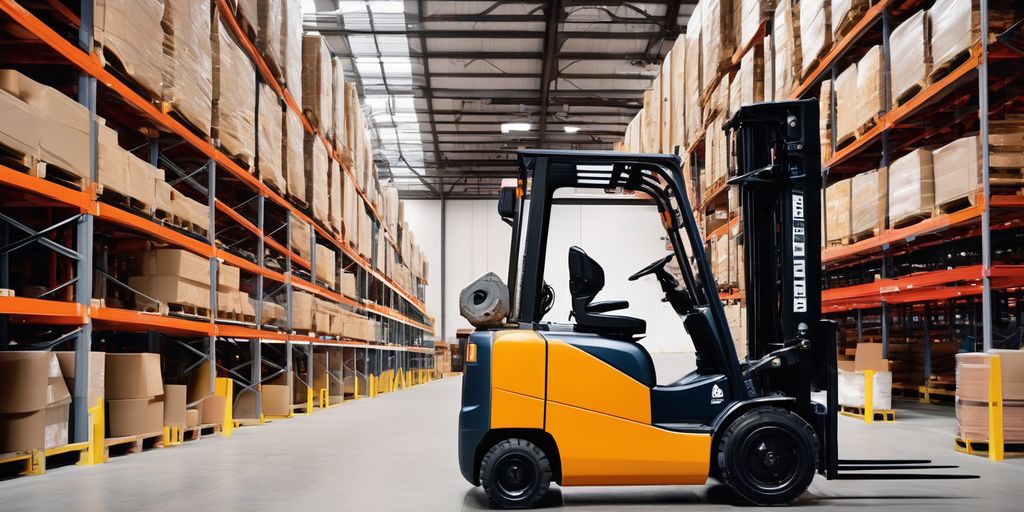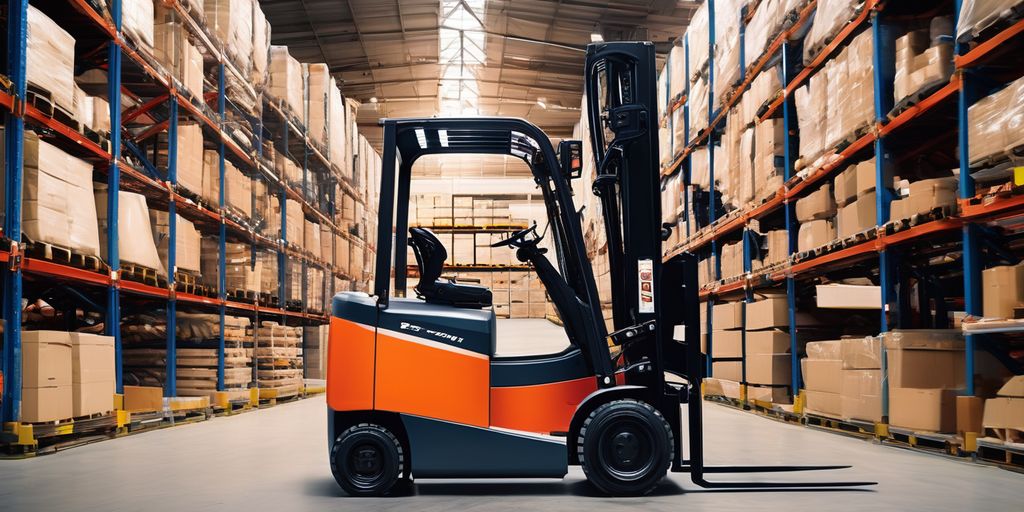Forklifts are essential tools in many industries, helping to move heavy loads with ease. If you're new to forklifts, this guide will help you understand the different types, their key features, and how they are used in various fields. We'll also cover safety tips and how to choose the right forklift for your needs.
Key Takeaways
- There are different types of forklifts, including electric, internal combustion, and rough terrain forklifts.
- Key features to look for in a forklift include load capacity, lift height, and maneuverability.
- Forklifts are used in many industries such as warehousing, construction, and agriculture.
- Specialized attachments like side shifters, fork positioners, and rotators can enhance a forklift's functionality.
- Safety measures are crucial for forklift operation, including pre-operation inspections and safe driving practices.
Understanding Different Forklift Types
To truly unleash the potential of your forklift, delve into the specifics of the machine you’re operating. The forklift manual is a treasure trove of detailed specifications, guiding you through its intended applications. Knowing your forklift type isn’t just a pro tip; it’s the key to maximizing efficiency for each unique task.
Electric Forklifts
Electric forklifts are powered by batteries and are ideal for indoor use. They are known for being quiet and producing no emissions, making them perfect for warehouses and other enclosed spaces. Electric forklifts are also easier to maintain compared to their internal combustion counterparts.
Internal Combustion Forklifts
Internal combustion (IC) forklifts run on fuels like gasoline, diesel, or propane. These forklifts are versatile and can be used both indoors and outdoors. They are generally more powerful than electric forklifts and can handle heavier loads. However, they do produce emissions and are noisier.
Rough Terrain Forklifts
Rough terrain forklifts are designed for outdoor use on uneven surfaces. They have large, rugged tires and a powerful engine to navigate through challenging environments. These forklifts are commonly used in construction sites, farms, and lumber yards.
Understanding your forklift type ensures you’re not just using a tool but harnessing a tailored solution for each job.
Key Features of Forklift Trucks

Forklift trucks are essential tools in many industries, known for their versatility and efficiency. They help in moving, positioning, loading, and unloading materials safely and quickly. [Understanding the essential parts of a forklift truck is crucial for safe and efficient operation.](https://www.aaaforklifts.com/blogs/news/understanding-the-essential-parts-of-a-fork-truck-a-comprehensive-guide)
Load Capacity
The load capacity of a forklift is a critical feature. It determines how much weight the forklift can safely lift and transport. Different forklifts have varying load capacities, so it's important to choose one that matches your needs. Overloading a forklift can lead to accidents and damage to the equipment.
Lift Height
Lift height refers to how high a forklift can raise its forks. This feature is especially important in warehousing and storage facilities where items need to be placed on high shelves. Forklifts with higher lift heights can reach greater heights, making them ideal for such environments.
Maneuverability
Maneuverability is the ability of a forklift to navigate through tight spaces and around obstacles. This feature is essential in environments with limited space, such as warehouses with narrow aisles. Forklifts with better maneuverability can operate more efficiently and safely in such conditions.
Understanding the essential parts of a forklift truck is crucial for safe and efficient operation. This guide explores forklift parts and functionalities for optimal performance and safety.
Applications in Various Industries
Forklifts are indispensable material handling equipment in the transportation and handling of goods, particularly within industries and warehouses. They do way more than just move pallets; their versatility extends across various sectors.
Warehousing
In warehouses, forklifts are essential for moving heavy loads and organizing inventory. They help in stacking goods on high shelves and retrieving them when needed. Maximizing forklift utility with extensions and attachments can significantly improve efficiency in these settings.
Construction
On construction sites, forklifts are used to transport building materials like bricks, steel beams, and concrete blocks. They are crucial for lifting and placing materials at different heights, making construction tasks easier and faster.
Agriculture
In the agricultural sector, forklifts assist in handling large quantities of produce, feed, and equipment. They are used to load and unload trucks, move bales of hay, and transport other heavy items around the farm.
Forklifts are not just for warehouses; they are versatile machines that can be adapted for various tasks across different industries.
Choosing the right attachments, assessing needs, ensuring compatibility, and consulting experts can help in optimizing forklift use in any industry.
Specialized Forklift Attachments
Forklifts are incredibly versatile machines, but their functionality can be further enhanced with specialized attachments. These attachments allow forklifts to handle a variety of tasks beyond just lifting and moving pallets. Choosing the right attachment can significantly improve efficiency and safety in your operations.
Side Shifters
Side shifters are attachments that enable the forks to move left and right. This allows for minor adjustments without having to move the entire forklift. They are particularly useful in tight spaces where precision is crucial.
Fork Positioners
Fork positioners allow the operator to adjust the distance between the forks. This is especially helpful when handling loads of varying widths. With fork positioners, you can quickly adapt to different load sizes without leaving the operator's seat.
Rotators
Rotators are attachments that allow the forks to rotate, making it easier to dump or invert loads. These are commonly used in industries where the contents of a container need to be emptied quickly and efficiently.
Using the right attachment can transform your forklift into a multi-functional tool, capable of handling a wide range of tasks with ease.
Safety Measures for Forklift Operation

Pre-Operation Inspections
Before operating, one should protect their well-being and the safety of others by remembering these safety tips:
- Only operate a forklift if you are authorized to do so.
- Become familiar with the features and functions of each forklift you operate.
- Give your forklift a thorough operational check each shift.
- Only use approved forklifts in designated areas and locations.
- Do not allow a pedestrian to pass under the forks or attachment of your forklift.
Safe Driving Practices
- Assume the responsibility for keeping your forklift under control at all times.
- Know your travel routes, that there is overhead clearance, that the bridge plates are secure, and that the warehouse and trailer floors are sufficiently strong.
- Do not allow anyone to ride on your forklift as a passenger.
- Never engage in reckless driving or horseplay.
- Protect your arms, legs, and other body parts by keeping them within the forklift and overhead guard area.
- Obey the rule against eating or drinking while driving so your full attention can be on your work.
Load Handling Techniques
- Pick up a load only when you are sure it is stable.
- Know and do not exceed the rated load capacity of your forklift.
- Be responsible for your forklift—never leave it unattended.
- Protect yourself by observing the “NO SMOKING” rule at refueling and recharging stations.
Safety first: Best practices for operating a forklift include understanding the importance of forklift safety, controls understanding, proper load handling, and visibility maintenance.
Choosing the Right Forklift for Your Needs
Assessing Work Environment
When selecting a forklift, it's crucial to consider your work environment. Indoor warehouses might benefit from electric forklifts due to their zero emissions, while outdoor construction sites may require rough terrain forklifts. Think about the surfaces the forklift will operate on and any potential obstacles.
Understanding Load Requirements
Knowing the weight and size of the loads you'll be lifting is essential. Forklifts come with different load capacities, and choosing one that matches your needs will prevent damage and ensure efficiency. Overloading a forklift can lead to accidents and equipment failure.
Evaluating Budget Constraints
Your budget will play a significant role in your decision. New forklifts offer the latest technology and warranties, but used models can be more cost-effective. Consider the long-term costs, including maintenance and repairs, when making your choice.
Remember, the best forklift for you will depend on your unique needs and budget. Do your research and choose wisely to ensure you get the most value for your investment.
Maintenance and Care for Forklifts

Regular Inspections
Regular inspections are crucial to ensure the longevity and safety of your forklift. Every 200-250 hours or six weeks, a full check-up and service should be performed. This includes inspecting and lubricating moving parts, replacing worn-out components, and checking the battery, brakes, and hydraulic system. Operator awareness plays a significant role in maintaining peak performance.
Battery Maintenance
Proper battery maintenance is essential for electric forklifts. Regularly check the battery's water levels and ensure it is fully charged. Clean the battery terminals to prevent corrosion and ensure a good connection. Always follow the manufacturer's guidelines for charging and maintenance to extend the battery's life.
Tire Care
Tire care is vital for the safe operation of a forklift. Regularly inspect tires for wear and damage, and ensure they are properly inflated. Different types of tires may require specific maintenance, so always refer to the manufacturer's recommendations. Proper tire care not only ensures safety but also enhances the forklift's maneuverability and load capacity.
Conclusion
In summary, forklifts are incredibly versatile machines that play a crucial role in many industries. From warehouses to construction sites, understanding the different types of forklifts and their specific applications can greatly enhance productivity and safety. Whether you are a beginner or looking to refresh your knowledge, knowing the right forklift for the job is essential. By choosing the appropriate forklift and using it correctly, you can ensure that tasks are completed efficiently and safely. Keep learning and stay safe!
Frequently Asked Questions
What are the main types of forklifts?
The main types of forklifts include electric forklifts, internal combustion forklifts, and rough terrain forklifts. Each type is designed for specific tasks and environments.
How do I choose the right forklift for my needs?
To choose the right forklift, consider your work environment, load requirements, and budget. Assessing these factors will help you select the most suitable forklift for your operations.
What are some key features to look for in a forklift?
Important features to consider include load capacity, lift height, and maneuverability. These features will impact how well the forklift performs in your specific application.
What industries commonly use forklifts?
Forklifts are commonly used in industries such as warehousing, construction, and agriculture. They help in moving and lifting heavy loads efficiently.
Are there any special attachments for forklifts?
Yes, there are specialized attachments like side shifters, fork positioners, and rotators. These attachments enhance the functionality of forklifts for specific tasks.
What safety measures should be followed when operating a forklift?
Always perform pre-operation inspections, follow safe driving practices, and use proper load handling techniques. These measures help ensure safe forklift operation.




Leave a comment
This site is protected by hCaptcha and the hCaptcha Privacy Policy and Terms of Service apply.